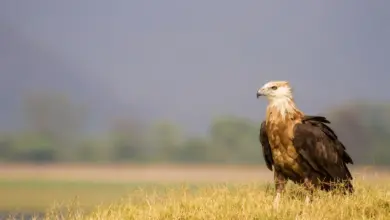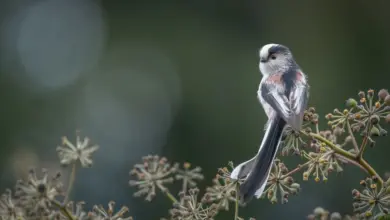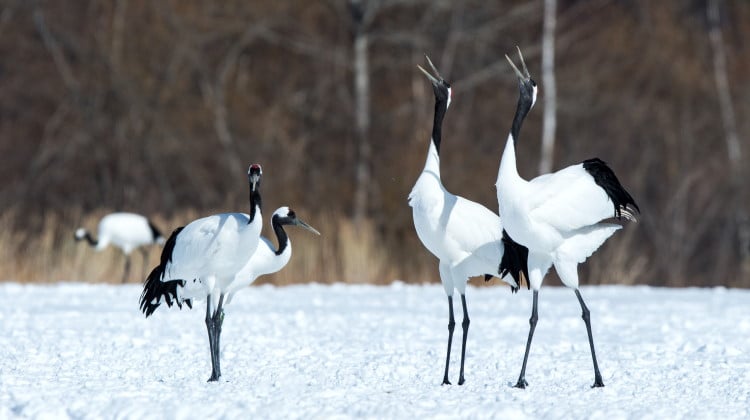Corvus: Genus Of The Jackdaw, Rook & Crow
The genus Corvus contains your typical corvids: black stocky birds with strong feet and bills.
Commonly they are known as Jackdaws, Rooks, Crows and Ravens in order of general size.
There are 39 species in the genus Corvus, most of which are known as crows. All the genus are excellent flyers and perform aerial acrobatics seemingly for the joy of it.
You can use these links to skip the section you are looking forward, otherwise keep reading!
Jackdaws (Corvus monedula) are the smallest and most social of the genus.
Konrad Lorenz, a well-renowned behavioural ecologist, says of Jackdaws “few birds – indeed few of the higher animals – possess so highly developed a social and family life”.
Jackdaws are socially monogamous, mating for life. They live in and breed in colonies. Within a colony there is a head bird and a second bird, etc. This is a social pecking order, in which each bird knows all the other birds and its relationship to them.
Jackdaws, like most other corvids, have adapted well to living with mankind. They have taken advantage of man’s ability to increase their available food supplies and nesting sites – since farming began and perhaps even before.
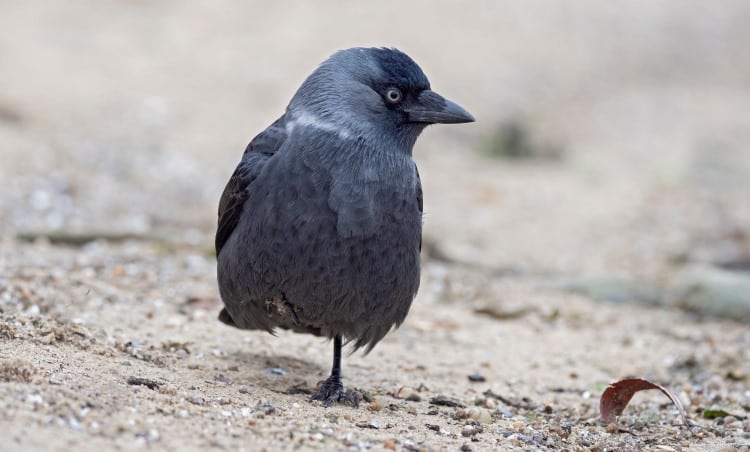
The Romans called them Monedula, which is now their species name.
The common English name arises from the ancient word ‘Daw’ meaning a simpleton and ‘Jack’ based on their ‘tchack’ call. Nowadays however we know that Jackdaws, like all the Corvus genus are not simpletons but among the most intelligent of birds.
Jackdaws occur across most of Europe, the Middle East, Russia and Asia to about lake Biakal. They are absent from Pakistan and India though. More northerly populations are migratory, however from Britain southwards they are generally more sedentary – though some British populations do migrate.
Jackdaws are not sexually mature until their second year.
Nesting starts in March to May depending on latitude. Both partners build the nest and 4-6 pale greenish-blue, lightly spotted eggs are laid. The female incubates and the male feeds her. Incubations lasts 16-20 days, taking longer the further north the population is located.
Both parents feed the young on a diet consisting mostly of invertebrates. Moulting starts for the adult while the young are still in the nest and lasts 105 days. Jackdaws are unique among corvids in their pale blue eyes.
The Damian or Daurian Jackdaw (Corvus dauricus) is the only other species of Jackdaw.
Distinguished by its whitish breast and its far eastern distribution from eastern Russia to Japan. Ecologically it is similar to the Common Jackdaw.
Rooks, Corvus frugilegus, have a distribution that stretches from the UK to Japan, but are absent from truly tropical climes as well as from the colder north.
Rook is an Anglo-Saxon name for the bird’s call.
Rooks are more omnivorous than other members of the genus, with more than 50% of their diet being composed of grains. They will also eat acorns and pine kernels. This has not made farmers love them, but modern research suggests that they do more good through consuming pests than they do harm by consuming grain. They also feed heavily on earthworms when grain is not available.
Rooks do not breed until they are 3 years old – and though they nest colonially – they are socially monogamous with each pair vigorously defending the territory immediately around the nest.
The breeding season commences in March and 3-5 eggs are laid in a tree top nest. Incubation takes 16-18 days and the male feeds the female during this time. Rooks are fully fledged at 40 days but cannot really feed themselves for another 20 days and are still partially dependent on their parents until they are about 5 months old.
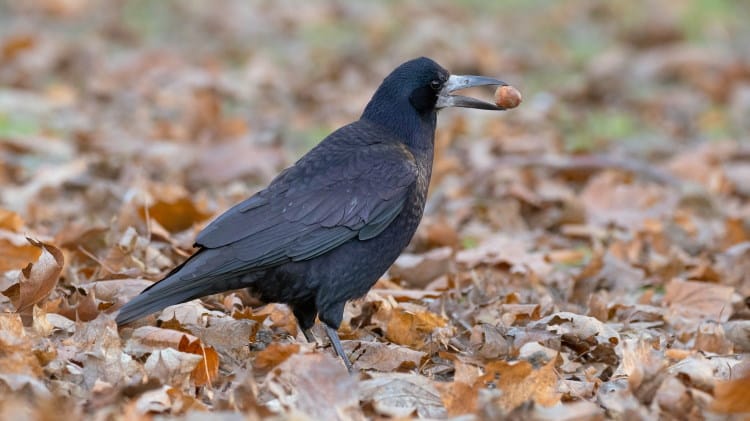
Adults begin their moult during the breeding season and it lasts for 107 days.
Rook populations have been declining in the UK since the 1950s.
In Sweden there is some evidence to suggest that Rook numbers are declining there as well as a result of poisoning from eating seeds dusted with mercury based seed coatings.
Rooks vs Crows
Wondering about the difference between rooks and crows?
Well, rooks are distinguishable from crows because of their white bills near their faces.
Rooks are colonial birds, nesting in small stands of trees year after year. They also remain as a flock when feeding. In the UK an old birdwatchers saw goes “A rook on his own be a crow, and a group of crows be rooks”.
However, Crows will roost in flocks, as will ravens, so this advice is best ignored at dawn and dusk.
Twenty five or perhaps 28 members of the genus Corvus hold the name Mr Crow.
Between them, they can be found in most parts of the world excepting the poles and South America.
The European Carrion Crow, Corvus corone, flies with regular wing beats in a dead straight line when going somewhere in particular, hence the common statement ‘such and such a place is x miles distant as the crow flies‘ meaning in a straight line.
There are 6 subspecies of the Carrion Crow, several of which are distinctly coloured in white or grey and are called Hooded Crows. Hooded Crows have a more northerly and easterly distribution than the Carrion Crow.
Carrion crows are solitary nesters and normally forage singly or in pairs, though they often roost in flocks.
Crows are omnivorous, killing sick or dead animals and ridding the country of many carcasses. Frequently they raid other birds nests for eggs, particularly those of Black-headed Gulls, Larus argentatus. They also eat insects, young and small birds, small mammals and various fruits and vegetables when times are hard. Like most corvids, they bury food to eat later.
The English populations are sedentary but in Europe they are often migratory, travelling up to 1500 km (1000 miles) from the overwintering grounds to their breeding grounds.
Crows do not breed until they are 3 years old.
Crows build very sturdy nests early in spring in forks high in the trees. Both sexes build the nest. The female incubates the 4-5 pale bluish-green eggs for 17-20 days during which time she is fed by the male. Young Carrion Crows take 30-35 days to fledge.
For some reason, fledgling mortality is higher in Crows than Rooks, Jackdaws and Ravens. Adult crows commence their moult before the young are fully fledged and moulting takes 133 days. Crows are monogamous and mate for life. They live for at least 12 years.
Corvus corone does not occur in India or its neighbouring countries. There its place, or ecological niche, is filled by the Indian House Crow, Corvus splendens. This crow lives in complete harmony with mankind in India and is regarded as beneficial because of its scavenging ways.
They are socially monogamous forming life-long pair-bonds.
They roost in huge flocks outside of the breeding season. Breeding occurs between March and August except for second year birds (first time breeders) which breed in October to December. They nest in typical crow-like nests in trees. More than one pair may use the same tree, but they are essentially solitary breeders.
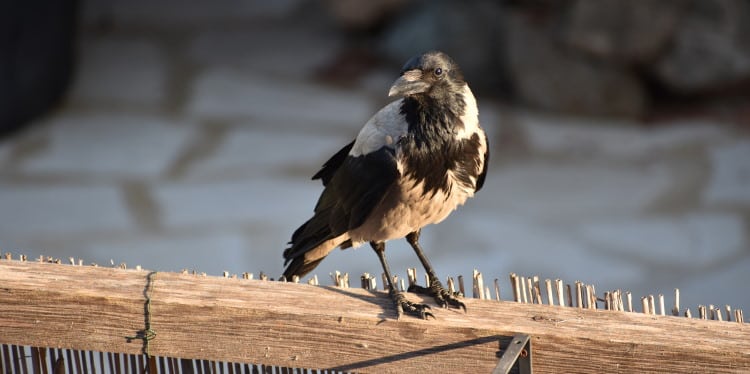
The 4-5 eggs hatch in 16-17 days. The Indian House Crow shares its territory with the Indian Jungle Crow, Corvus macrorhynchus.
The Indian Jungle Crow is not really a bird of jungles, preferring to live on the edges of woodlands near human habitation. It has a wider distribution than the Indian House Crow, occurring further to the northwest and east into China, Japan and Indochina. There are 14 sub-species of C. macrorhynchus. It has a smaller throat and larger more arched bill than C. splendens.
Through Indonesia and the nearby Pacific islands are 10 species of crows, all fairly similar in look and habit. Of these Corvus enca is the most widespread with 8 sub-species.
Africa has two species of crow; the Black Crow, Corvus capensis, and the Pied Crow, Corvus albus. Both species have similar habits to the Carrion Crow though breeding occurs at different times in different parts of Africa in response to the widely variable environmental conditions.
Australia has only members of the genus Corvus, to represent the family Corvidae. Of these, two are Crows and three are Ravens
The Australian Crow, Corvus orru, occurs all across from Cape York to Tasmania though it is not recorded as breeding in S. Australia, Victoria, Tasmania and most of NSW, where it is displaced by the Little Crow, Corvus bennetti. Both species are all black with glossy highlights of purple and greens. The Australian Crow is the larger of the two and breeds from October and its nest is less substantial than those of most corvids.
The Little Crow is a nomadic species travelling in flocks to wherever food is plentiful. It breeds at any time of the year if the conditions are right, i.e. recent rainfall. It nests colonially and builds the normally solid type of corvid nest.
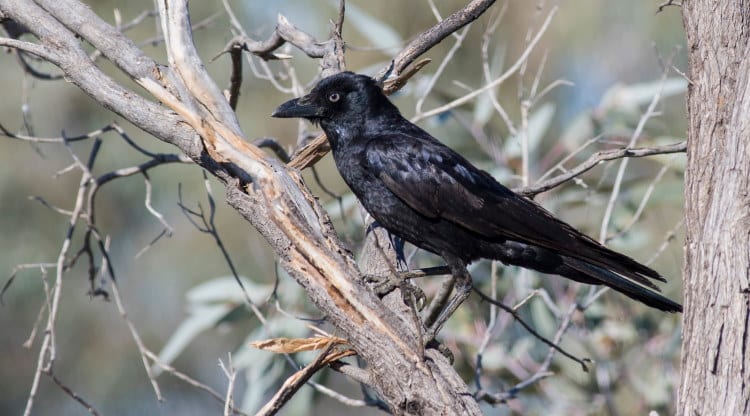
The rest of the genus Corvus occur in north and central America.
The most familiar species is the American Common Crow, Corvus brachyrynchos, of which there are 4 sub-species. It is a migratory species with the usual omnivorous diet and playful attitude to life.
They nest as solitary monogamous pairs though often with many other pairs not too distant. Both parents incubate the eggs for 17-20 days. During Autumn and Winter they live in large flocks roosting in the same sites year after year.
One exceptional roost in Baltimore was estimated to contain 230,000 crows.
The other N. American crows are the Fish Crow, Corvus ossifragus, which occurs only on the east Coast of the USA, and the Northern Crow, Corvus caurinus, which occurs in Canada and northwest USA. The Northern Crow is a colonial nester. The Fish Crow is smaller than the Common American Crow with whom it shares its range. It nests from April to May in small colonies of 2-3 pairs.
In Mexico there are either 2 sub-species of the Mexican Crow, or two species of crow, namely Corvus imparatus and Corvus sinaloae. Mexican crows are smaller than their N American cousins and more colourful with a seasonal shift in sheen from purplish in November to March, to greenish from April to June.
The other Central American Crows are the Palm Crow, Corvus palmorum, with two sub-species, one in Cuba and one in Hispaniola. The Jamaican Crow, Corvus jamaiciensis, is found only in Jamaica. The Cuban Crow, Corvus nasicies, the White-necked Crow, Corvus leucocephalus, occur in Hispaniola and Puerto Rico.
The last 3 all have diminishing populations and suffer heavily as a result of man’s destruction of their habitat.
The ten species of Ravens in the world are the largest members of the family Corvidae and of the genus Corvus.
Ravens occur all over the world, though most do not have the large distribution of Corvus corax, the Common Raven.
This Raven, a common creature in mythology and folklores – and often associated with wisdom – has been so persecuted by farmers and gamekeepers in England (and most of central and western Europe) that they were relatively uncommon.
Recently, this persecution has stopped and their numbers are starting to increase again.
Common Ravens are long-lived birds, easily reaching 50 years of age with one specimen known to have been 69 years old.
They do not start breeding until they are 3 years old. Courtship involves some spectacular flying by the male, including gliding upside down. Breeding begins early in the year – February to March.
Ravens are socially and probably genetically monogamous. Nests are solid, bulky structures build on cliff edges or high in tall trees.
Old nests are often reused. Both birds help to make the nest.
The female lays 4-6 eggs and incubates them for about 20 days. The male feeds her during this time. Both parents feed the young which takes 42-45 days to fledge. Food is carried to the young in the throat pouch
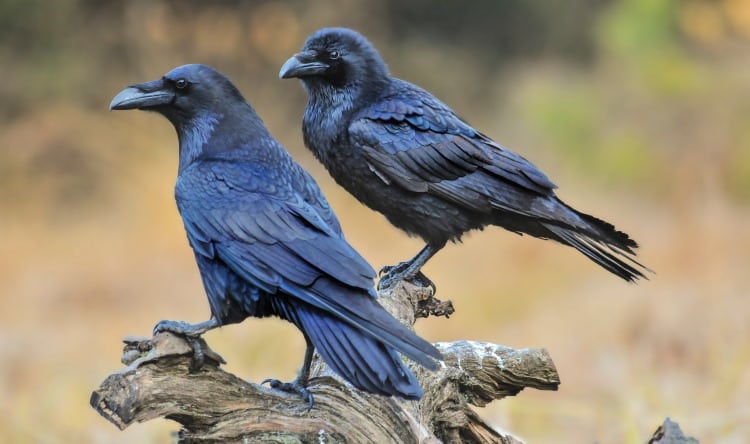
Outside of the breeding season, Ravens will roost in flocks of often over 100 birds and over 1,000 is not unknown.
These roosts persist during the breeding season as well, though they contain only immature non-breeding birds at this time. Adults start to moult during the fledging period and moult lasts for 140-150 days.
Ravens are primarily scavengers on carcasses and during the lambing season live on ewes’ afterbirths.
The remaining Raven species are found in Africa, Australia and America and are all very similar in their ecology. The Dwarf Raven, a sub-species of the Brown-necked Raven, Corvus ruficallis, is a loose colonial nester in trees.
Ravens vs Crows
The main difference or distinguishing factor between ravens and crows is the ravens greater size.
But ravens are distinguished from crows not only by their larger size, but also by their throat hackles – the projecting feathers under the chin and in the throat.
Ravens have relatively long throats.
All Ravens are intelligent, inquisitive, generally friendly birds. They live in harmony with wolves in America, by whom they are accepted. Ravens can easily be taught human speech and can learn how to count. There are many stories like the following:
A caged Raven was helped to escape by two wild Ravens – who dug a hole into its cage from the outside while the caged bird dug out from the inside.
Ravens have been much maligned by man in the past, though modern research has shown that they – like crows – do far more good than harm by their scavenging lifestyles.
Raven Mythology
The mythology surrounding ravens is most diverse and fascinating.
Firstly, understand ravens are scavengers.
They follow wolves, coyotes and polar bears in order to garner from the remains of their kills. It is highly likely that they had a similar relationship with prehistoric man. It would seem reasonable to assume that – by the time written records could be left behind – mankind and ravenkind knew each other well.
Birds which look to be Ravens or Crows occur among the cave paintings of Lascaux (France) and are among the 12 bird species depicted in Neolithic cave paintings in the Tajo Segura Cave in Spain.
Mythological and Cultural Examples
The Raven is a bird to be noticed and as such it gets mentioned in the Bible – Elijah is fed by them and Noah sends them out to find dry land (and they don’t return).
Shakespeare includes mention of them in about half of his plays. Edgar Allen Poe wrote one of the most famous poems in the English with a Raven as one of its major characters. Dickens included them in Barnaby Rudge.
Few other birds have such a literary claim to fame. They are true birds of myth (well – in a sense – they do exist!)
They are, apparently, named in the Koran as well.
To the ancient Romans, the Raven was the most important bird for omens and Ravens were kept as pets by legionnaires.
To the Norsemen the Raven was the sacred bird of their religion – Odin was apparently accompanied by two Ravens, Hugin and Munin (Thought and Memory). Each day they flew across the world, returning in the evenings to Odin’s shoulders to report to him what they had seen. Odin is/was the Raven God and the war banner of the Norsemen was fashioned in the form of a Raven.
Across the whole of the northern hemisphere the Raven is regarded as a bird of omen – a messenger for the Gods and a harbinger of death. This is probably as a result of its taste for feeding on carcasses, human as well as any other.
Before the Middle Ages, the Raven was looked upon kindly in the UK – where it was honoured for its role as a scavenger helping to keep the cities clean. Up to the late 1400s it was protected by law in many cities. Ravens still live in London, nesting in the Tower of London.
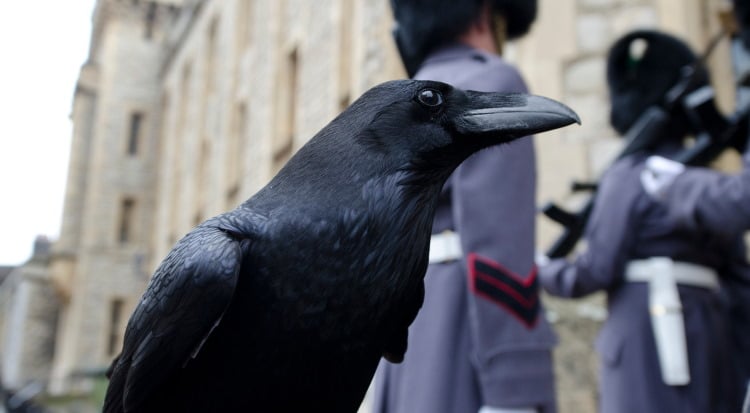
Mythology claims the tower will crumble and collapse and the Monarchy be in danger if less than 6 Ravens live there!
In the countryside they were not so appreciated and were blamed for many dead lambs. This would have been as the result of their habit of feeding on the afterbirth of sheep, as well as on stillborn and recently dead lambs.
To many North American Indians, the Raven was a bird of extraordinary knowledge and power. It was honoured as being unearthly and it is a frequent totem animal in North American mythology and culture.
The Inuits have a myth telling how the Raven invented light by throwing chips of mica into the air.
By the 1500s, the Raven had lost its protected status in the UK – where it was then persecuted as it was in much of the rest of western Europe. Bounties were paid for it up until the 1800s.
During the 20th century however, Ravens have gradually come to be respected in much of Europe – though they are still often blamed by farmers for the deaths of lambs.
Final Thoughts
Ravens in particular, but also all the other members of the Genus Corvus are wonderful intelligent, playful birds – who well repay the effort spent in getting to know them.
Considering that crows and their kin are so common in many towns and cities, it is a shame they are not more respected – and I hope this short introduction to them will inspire you to read up on and observe their thoroughly fascinating behaviour more honestly.


